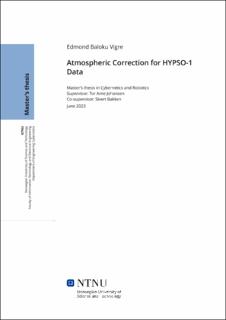| dc.description.abstract | Denne masteroppgaven undersøker bruken av ACOLITE for atmosfærisk korreksjon på HYPSO-1 data, sammenligner den med to andre korreksjonsmetoder (6S og ELF), og analyserer forskjellene til en ny versjon av HYPSO-1 kalibreringen. Denne oppgaven har som mål å utlede nøyaktige data for miljøapplikasjoner, som overvåking av skadelige algeoppblomstringer, ved å evaluere og sammenligne ytelsen til ulike korreksjonsalgoritmer.
Oppgaven viser at ACOLITE presterer bedre enn 6S og ELF når det sammenlignet med data fra bakkestasjoner. Til tross for utfordringer som negative reflektanseverdier i lavere bølgelenger og variasjoner i resultatene, viser ACOLITE med sin DSF algoritme seg å være et mer egnet valg for atmosfærisk korreksjon av HYPSO-1-data. Imidlertid påpeker analysen også behovet for et mer omfattende datasett, spesielt med variasjon av ulike typer vanntyper, for å fullstendig evaluere ACOLITE sin ytelse.
I tillegg til ACOLITE, undersøker denne oppgaven en ny kalibreringsmetode for HYPSO-1 data. Foreløpige sammenligninger mellom gamle og nye kalibreringskoeffisienter, i tråd med data fra bakkestasjoner, indikerer potensielle forbedringer i nøyaktigheten av den atmosfæriske korreksjonsprosessen. Imidlertid er ytterligere validering med et større datasett nødvendig for å bekrefte disse funnene.
Totalt sett understreker forskningen lovende resultatene av ACOLITE for korreksjon av HYPSO-1-data og potensialet for forbedret nøyaktighet med den nye kalibreringsmetoden. Det legges vekt på viktigheten av kontinuerlig undersøkelse og forbedring av visse aspekter, samtidig som det erkjenner utfordringene har blitt møtt. Ved å bidra til å finne en optimal metode for atmosfærisk korreksjon av HYPSO-1-data, tjener denne oppgaven som en verdifull referanse for fremtidig forskning på dette området.
Inntil videre funn av en annen korreksjonsmetoder som passer bedre til HYPSO-1 data for både land- og vannapplikasjoner, er ACOLITE den beste løsningen for atmosfærisk korreksjon. Imidlertid kreves det fremtidig arbeid med forbehandlingsprosedyrene for å håndtere negative reflektanseverdier rundt 400-500 nm. I tillegg bør den nye kalibreringsmetoden valideres ytterligere med en større datasett for å bekrefte effektiviteten. Til slutt ville en sammenligningsanalyse med andre satellittoppdrag, som Sentinel eller Landsat, gi en verdifull referanse for å vurdere nøyaktigheten til ACOLITE for HYPSO-1-data. | |
| dc.description.abstract | This Master's thesis investigates the application of the ACOLITE atmospheric correction on HYPSO-1 satellite data, comparing it with two other correction methods (6S and ELF), and analyzing the effectiveness of a newly introduced calibration method. The research aims to derive accurate data for environmental applications, such as monitoring harmful algal blooms, by evaluating and comparing the performance of different correction algorithms.
The study demonstrates that ACOLITE outperforms the 6S and ELF methods in terms of alignment with ground station data. Despite challenges encountered, including negative reflectance values at lower wavelengths and output variations, ACOLITE, with its dark spectrum fitting algorithm emerges as a more suitable choice for atmospheric correction of HYPSO-1 data. However, the analysis also highlights the need for a more extensive dataset, particularly captures over various type water bodies, to comprehensively evaluate ACOLITE's performance.
In addition to ACOLITE, this thesis examines a newly introduced calibration method for HYPSO-1 captures. Preliminary comparisons between the old and new calibration coefficients, in line with ground station data, indicate potential improvements in the accuracy of the atmospheric correction process. However, further validation with a larger dataset is necessary to confirm these findings.
Overall, the research underscores the promising results of ACOLITE for HYPSO-1 data correction and the potential for enhanced accuracy with the new calibration method. It emphasizes the importance of ongoing investigation and improvements in certain aspects, while acknowledging the challenges encountered during the study. By contributing to find an optimal method for atmospheric correction of HYPSO-1 data, this thesis serves as a valuable reference for future research in this domain.
Until another correction method that performs better and suits HYPSO-1 data even more is found, ACOLITE is the best fit for atmospheric correction of HYPSO-1 data. However, future work of the pre-processing steps is required to address the negative reflectance values around 400-500 nm. In addition, the new calibration method should be further validated with a larger dataset to confirm its efficacy. Lastly, a matchup analysis with other satellite missions, such as Sentinel or Landsat, would provide a valuable comparison benchmark for assessing the accuracy of ACOLITE for HYPSO-1 data. | |
